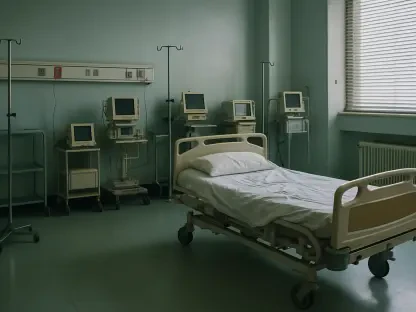Imagine the joy of expecting a new child suddenly overshadowed by the chilling discovery of a lump in the breast, later confirmed as cancer, striking thousands of women each year and blending the miracle of life with a life-threatening illness. For someone like Stephanie Wysaski, a 35-year-old mother from Naperville, Illinois, the diagnosis of invasive lobular carcinoma during her fourth pregnancy turned a time of anticipation into one of profound uncertainty. Her story illuminates the intricate challenges that arise when breast cancer intersects with pregnancy, creating a maze of medical restrictions, emotional turmoil, and logistical burdens. The complexity of managing such a diagnosis while safeguarding an unborn child presents unique obstacles that go far beyond the typical cancer journey, affecting not just the patient but the entire family dynamic.
The emotional weight of receiving such news during pregnancy is staggering, as the mind races between concern for personal health and the well-being of the baby. Physical exhaustion from both conditions compounds the struggle, while the inability to fully assess or treat the disease until after delivery heightens anxiety. Family responsibilities do not pause, demanding a delicate balance between maintaining normalcy for children and addressing critical health needs. Stephanie’s experience underscores these multifaceted challenges, offering a window into the broader issues faced by pregnant women with breast cancer. Her determination to navigate this dual reality highlights the resilience required to face such a diagnosis under extraordinary circumstances.
Medical Challenges During Pregnancy
Navigating Diagnostic Barriers
When breast cancer is suspected during pregnancy, the usual diagnostic pathway is disrupted by the need to protect the fetus from potential harm. Procedures like contrast MRIs and PET scans, which provide detailed insights into the spread of cancer, are often deemed unsafe due to risks to the unborn child. In Stephanie’s case, this meant that after her lumpectomy, the full scope of her cancer—whether it had metastasized beyond the breast and lymph nodes—remained a mystery until after her delivery. This limitation creates a significant gap in understanding the disease’s progression, leaving both patient and medical team in a state of limbo. The delay in staging the cancer not only prolongs uncertainty but also postpones the formulation of a comprehensive treatment plan, adding layers of stress to an already fraught situation.
The absence of critical diagnostic data during pregnancy often forces healthcare providers to rely on less invasive or less precise methods, such as non-contrast imaging or biopsies, which may not fully capture the extent of the disease. For Stephanie, initial imaging underestimated the tumor size, revealing a much larger mass during surgery. This discrepancy highlights how pregnancy can obscure the true nature of the cancer, potentially impacting early intervention strategies. The wait for definitive answers, which can span months until after childbirth, tests the patience and emotional endurance of affected women. Such constraints emphasize the urgent need for alternative diagnostic approaches that can safely provide clarity during this critical period, ensuring that treatment decisions are based on accurate information.
Adapting Treatment Protocols
Treatment options for breast cancer are heavily influenced by pregnancy, as the priority to safeguard the baby often restricts standard approaches. Radiation therapy, a common component of cancer care, is typically avoided due to its potential to cause miscarriage, birth defects, or developmental issues in the fetus. In contrast, certain chemotherapy regimens are considered safe after the first trimester, as was the case for Stephanie, who completed four rounds while pregnant. However, these treatments are carefully tailored and closely monitored by maternal-fetal medicine specialists to minimize risks. Decisions such as inducing delivery earlier than planned—Stephanie’s was scheduled at 34 weeks—reflect the delicate balance between addressing maternal health needs and ensuring the baby’s safety, allowing for more aggressive interventions post-delivery.
Even with adapted treatments, the limitations during pregnancy can leave women feeling vulnerable, as the full arsenal of cancer-fighting tools remains out of reach until after childbirth. The psychological impact of knowing that some therapies are on hold can be profound, as patients grapple with the fear that their condition might worsen in the interim. For Stephanie, the completion of chemotherapy offered some reassurance, but the looming possibility of needing radiation or a mastectomy later added to her concerns. Medical teams must navigate these restrictions with precision, often collaborating across specialties to ensure both mother and child receive optimal care. This tailored approach, while necessary, underscores the unique challenges of treating breast cancer in pregnant women, where every decision carries heightened stakes.
Emotional and Psychological Impact
Coping with Prolonged Uncertainty
The shadow of uncertainty looms large for pregnant women diagnosed with breast cancer, as the inability to fully assess the disease’s spread until after delivery creates a persistent source of anxiety. For someone like Stephanie, the lack of clarity about whether her cancer had advanced beyond the initial findings was a constant weight on her mind. Yet, she managed this fear by focusing on immediate, actionable steps such as completing her chemotherapy rounds and preparing for an early delivery. This approach of breaking down the overwhelming situation into manageable tasks is a common coping mechanism among women in similar circumstances. The emotional limbo of waiting for critical answers while nurturing new life amplifies the stress, making each day a test of resilience as they balance hope for their baby with concern for their own survival.
Beyond the immediate worry, the prolonged uncertainty affects long-term emotional well-being, often leading to heightened vigilance about every symptom or change in condition. The mind can easily wander to worst-case scenarios, especially during quiet moments or sleepless nights. For many women, the fear of leaving their children behind or not being there for the newborn drives a deep-seated need to stay strong. Support from counselors or peer groups can play a vital role in managing these fears, offering a space to express vulnerabilities that might be suppressed in daily interactions. Stephanie’s determination to maintain a pragmatic mindset highlights the inner strength required to navigate this uncertainty, but it also reveals the emotional toll of living with unanswered questions for months on end.
Juggling Family Roles Amidst Illness
Maintaining a semblance of normalcy for young children while battling breast cancer during pregnancy is an extraordinary challenge that tests emotional and physical limits. Stephanie worked tirelessly to keep up with routine activities like school drop-offs and planning birthday celebrations for her three children, despite the exhaustion from both her illness and treatment. This effort to shield her kids from the gravity of her condition reflects a common desire among affected mothers to preserve a sense of stability at home. However, the internal conflict of not being fully present—physically or emotionally—often breeds feelings of guilt and inadequacy, adding to the psychological strain of an already burdensome situation.
The dual role of being a patient and a parent creates a unique emotional tug-of-war, where the instinct to protect family clashes with the need for personal healing. Many women in this position find themselves suppressing their own fears to avoid alarming their children, which can lead to a buildup of unaddressed stress. Stephanie’s story illustrates how the drive to maintain family routines serves as both a distraction from the illness and a source of purpose, yet it comes at the cost of personal downtime. The emotional labor of reassuring loved ones while grappling with one’s own mortality is immense, often requiring external support to alleviate the pressure. This balancing act reveals the depth of resilience needed to fulfill maternal duties while facing a life-altering diagnosis under such constrained circumstances.
Family and Logistical Struggles
Leaning on a Support Network
Navigating breast cancer during pregnancy often necessitates a robust support system to manage the myriad demands of treatment and family life. For Stephanie, the involvement of her husband, Jay, and her mother was indispensable, as they took on significant responsibilities such as childcare and household tasks during her frequent medical appointments. Jay’s decision to take extended leave after the baby’s arrival further illustrates the critical role family plays in easing the burden. This network of support not only helps with practical needs but also provides emotional reassurance, allowing women to focus on their health without the added worry of daily logistics falling apart. Such assistance is often the backbone that keeps families functioning during these trying times.
However, even with strong support, the reliance on others can introduce new dynamics and pressures within the family. Coordinating schedules, communicating needs, and managing the expectations of those helping out requires constant effort, which can be draining for someone already stretched thin by illness and pregnancy. In Stephanie’s case, her mother’s temporary move to assist with the children was a lifeline, yet it also meant adjusting to shared living arrangements under stressful conditions. The gratitude for help is often tempered by a sense of loss of independence, as patients may feel they are burdening loved ones. This complex interplay of support and dependency underscores how family involvement, while essential, adds another layer of emotional and logistical navigation during an already challenging period.
Tackling Everyday Responsibilities
The sheer volume of responsibilities that come with managing breast cancer, pregnancy, and parenting young children can be overwhelming, requiring exceptional organizational skills and endurance. Stephanie, who also lives with type 1 diabetes, faced a relentless schedule of medical visits for both her cancer treatment and prenatal care, all while ensuring her children’s daily needs were met. The effort to keep family life running smoothly—attending school events, preparing meals, and maintaining routines—becomes a monumental task when energy levels are depleted by illness and treatment side effects. These routines, however, often serve as a grounding force, offering a sense of purpose amidst the chaos of a health crisis.
The logistical strain extends beyond time management to the mental load of planning and anticipating needs, often with limited physical capacity to execute them. For many women in similar situations, the inability to fully engage in parenting duties due to fatigue or medical commitments can lead to frustration and a sense of disconnection from family life. Stephanie’s determination to push through, despite feeling physically and emotionally drained, reflects the grit required to juggle these competing demands. The added complexity of coordinating with healthcare providers for multiple conditions further complicates daily life, leaving little room for rest or self-care. This relentless pace highlights the extraordinary challenges faced by pregnant women with breast cancer, where every day is a balancing act of health and home.
Importance of Awareness and Early Detection
Emphasizing the Value of Self-Exams
Early detection remains a cornerstone in the fight against breast cancer, and its importance is magnified during pregnancy when health concerns might be attributed to other causes. Stephanie’s discovery of a lump through a self-exam, prompted by a casual reminder on a television show, proved to be a pivotal moment that led to her timely diagnosis. Initially dismissing the lump as a clogged milk duct related to nursing, she mentioned it to her OB-GYN, a decision that ultimately altered her medical trajectory. This incident serves as a powerful testament to the impact of self-awareness, demonstrating how a simple act of checking one’s body can uncover a serious condition that might otherwise go unnoticed for months.
The significance of self-exams cannot be overstated, especially for women who may not consider themselves at high risk due to age or lack of family history. Pregnancy often brings a host of physical changes that can mask symptoms of breast cancer, making vigilance all the more critical. Educational campaigns and media reminders, like the one that influenced Stephanie, play a vital role in encouraging women to prioritize regular checks, even during busy or transformative life stages. Her experience underscores the potential life-saving impact of early detection, urging healthcare providers to reinforce the importance of self-exams as part of routine prenatal care. By staying attuned to their bodies, women can catch warning signs early, paving the way for interventions that could significantly improve outcomes.
Challenging Assumptions About Risk Factors
Traditional perceptions of breast cancer often associate it with older age or a strong family history, but cases like Stephanie’s challenge these outdated notions and highlight the disease’s reach across diverse demographics. At 35 and with no significant genetic predisposition, her diagnosis during pregnancy reflects a growing recognition within the medical community that breast cancer does not adhere to predictable patterns. This shift in understanding calls for broader education and screening initiatives that target younger women, including those who are pregnant, ensuring they are not overlooked simply because they don’t fit the conventional risk profile. Such awareness is crucial in catching cases early, when treatment options are often more effective.
The evolving perspective on who is at risk also emphasizes the need for tailored medical approaches that account for unique circumstances like pregnancy. Stephanie’s story brings attention to the importance of not dismissing symptoms based on age or life stage, as delays in investigation can have serious consequences. Medical professionals are increasingly advocating for inclusive guidelines that encourage proactive health checks for all women, regardless of assumed risk levels. Public health efforts must continue to amplify these messages, breaking down stereotypes and fostering a culture of vigilance. By recognizing that breast cancer can affect anyone, society can better support early detection and intervention, ultimately improving survival rates and quality of life for countless individuals.
Reflecting on Resilience and Future Steps
Looking back, Stephanie’s journey through a breast cancer diagnosis during pregnancy revealed the profound hurdles that arose at the intersection of health and motherhood. Her experience painted a vivid picture of the medical constraints that delayed critical insights into her condition, the emotional strain of uncertainty that tested her resolve, and the logistical challenges that demanded unwavering family support. Each step she took, from undergoing chemotherapy to preparing for an early delivery, showcased a remarkable strength that carried her through moments of doubt and exhaustion. Her story stood as a powerful reminder of the human capacity to endure, even when faced with overlapping crises that seemed insurmountable at times.
Moving forward, the focus shifts to actionable measures that can better support women in similar situations, ensuring they are not left to navigate these complexities alone. Healthcare systems should prioritize research into safe diagnostic tools for pregnant patients, reducing the agonizing wait for answers. Enhanced education on self-exams and risk awareness must reach broader audiences, empowering women to take charge of their health regardless of age or circumstances. Additionally, expanding access to psychological support and family resources can alleviate the emotional and logistical burdens, fostering a more holistic approach to care. Stephanie’s perseverance paved the way for hope, and by building on such stories, society can create a stronger framework to protect and uplift those facing breast cancer during pregnancy, turning individual struggles into collective progress.









